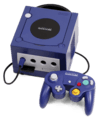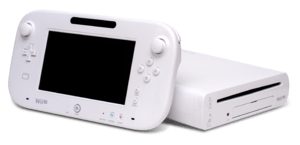Nintendo optical discs
|
Nintendo GameCube Game Disc (left) and Wii Optical Disc (right) | |
| Media type | Read-only optical disc |
|---|---|
| Encoding | Digital |
| Capacity |
GameCube: 1.5 GB Wii: 4.7 GB / 8.54 GB Wii U: 25 GB |
| Read mechanism | Laser |
| Developed by |
Nintendo Panasonic |
| Dimensions |
GCN: 8 cm (3.1 in) Wii/Wii U:12 cm (4.7 in) |
| Usage |
Nintendo GameCube Wii Wii U |
| Extended from | Nintendo Gamecube Game Disc |
| Extended to | Wii U Optical Disc |
Nintendo optical discs are the optical disc format used to distribute video games released by Nintendo. This includes the Nintendo GameCube Game Disc, Wii Optical Disc, and Wii U Optical Disc. The physical size of a GameCube Game Disc is that of a miniDVD, and the Wii and Wii U Optical Discs are the size of a DVD. GameCube discs can be used with the original version of the Wii and Wii Optical Discs can be used in the Wii U for backward compatibility. A burst cutting area is located at the inner ring of the disc surface.
Format

| Optical discs |
|---|
|
Optical media types
|
|
Standards
|
Nintendo GameCube Game Disc
The Nintendo GameCube Game Disc (DOL-006) is the game medium for the GameCube, created by Matsushita (Panasonic),[1] and later extended for use on the Wii through backward compatibility.[2] The GameCube Game Disc is a 1.5 GB,[3] 8 cm miniDVD based technology which reads at a constant angular velocity (CAV). It was chosen by Nintendo to prevent copyright infringement of its games,[4] to reduce cost[5][6] by avoiding licensing fees to the DVD Forum and to reduce loading times. This also prevents the consoles from being used as general DVD players.[7][8]
One downside to the GameCube Game Disc is the relatively small amount of storage they provide. As a result, some games with large amounts of data needed to be placed across two discs, such as Resident Evil 4. Multi-platform games that fit on PlayStation 2 and Xbox DVD discs occasionally saw the removal of certain features in order to fit on GameCube Game Discs. Full-motion video scenes and audio are more compressed to fit on a single disc, reducing their quality. Prior to the GameCube, Nintendo consoles traditionally used cartridge-based media.
Wii Optical Disc
The Wii Optical Disc (RVL-006) is the physical game medium for the Wii, created by Panasonic. Nintendo extended their proprietary technology to use a full size 12 cm, 4.7/8.54 GB DVD-based disc, enabling it to have the benefits of the Nintendo GameCube Game Disc, while having the standard capacity of a double-layer DVD-ROM. Although the Wii can use double-layer discs, all titles were single-layer prior to the release of Super Smash Bros. Brawl.[9][10] With the release of Super Smash Bros. Brawl, Nintendo admitted that some Wii systems may have trouble reading dual-layer discs due to a dirty laser lens.[10][11] Nintendo repaired systems with dual-layer problems,[10] and later released a disc cleaning kit for users to purchase.[12]
Wii U Optical Disc
The Wii U Optical Disc (WUP-006) is the physical game medium for the Wii U, with a capacity of 25 GB. The Wii U system is backward compatible with Wii Optical Discs, but not backward compatible with Nintendo GameCube game discs.[13] The optical discs used for the Wii U differ in appearance from most other optical discs in that they have soft, rounded edges.[14]
The format was developed and supplied by Panasonic, which is one of the major patent holders in Blu-ray technology. It is not clear whether the Wii U Optical Disc is similar in physical design to the Blu-ray physical disc specification. The late Nintendo president, Satoru Iwata stated, "Wii U does not have DVD or Blu-ray playback capabilities. The reason for that is that we feel that enough people already have devices that are capable of playing DVDs and Blu-ray, such that it didn't warrant the cost involved to build that functionality into the Wii U console because of the patents related to those technologies."[15]:3
Burst cutting area
Each Nintendo optical disc contains a burst cutting area (BCA) mark, a type of barcode that is written to the disc with a YAG laser. The data stored in this BCA mark includes an encrypted table related to the hardware-based copy-protection mechanics, in addition to 64 bytes of un-encrypted user-accessible data.[16]
A BCA mark is visible to the naked eye. It should not be confused with the IFPI mark that is on all optical discs. BCA is described in Annex K of the physical specification, and can be seen between radius 22.3±0.4 mm and 23.5±0.5 mm. There are also six additional evenly spaced small cuts just outside the BCA radius, which are related to the copy-protection used. These small cuts can clearly be seen if the disc is held in front of a strong light source.[16]
See also
References
- ↑ "Dvd - Faq". Nintendo World Report. 2001-03-07. Retrieved 2011-07-06.
- ↑ Casamassina, Matt (2006-09-12). "IGNcube's Nintendo "Revolution" FAQ". IGN. Retrieved 2006-09-07.
- ↑ "Nintendo GameCube Special Edition". Avrev.com. 2003-06-01. Retrieved 2011-07-06.
- ↑ "Beginner's Guide: GameCube". GameSpy. 2003-07-30. Retrieved 2006-09-07.
- ↑ Pian, Sharon (2001-11-11). "Business & Technology | Let the games begin: The 3-way race is on | Seattle Times Newspaper". Community.seattletimes.nwsource.com. Retrieved 2011-07-06.
- ↑ "Dvd - Faq". Nintendo World Report. 2001-03-07. Retrieved 2011-07-06.
- ↑ "Play it again". Smh.com.au. 2003-09-13. Retrieved 2011-07-06.
- ↑ "Wii U will not feature DVD playback - Everybody Plays - Nintendo Wii". Everybody Plays. Everybody Plays. Retrieved 2011-07-06.
- ↑ "Review – Super Smash Bros. Brawl". SlashGear. Retrieved 2011-07-06.
- 1 2 3 "Tobacco smoke makes Super Smash Bros Brawl unplayable on Wii". TG Daily. 2008-02-06. Retrieved 2011-07-06.
- ↑ Scott Colbourne (2008-03-20). "Not just a smash, a Super Smash". Toronto: The Globe and Mail. Retrieved 2011-07-06.
- ↑ Nintendo of America. "Repair Form for U.S. Residents". Nintendo of America. Archived from the original on March 10, 2008. Retrieved 2008-03-09.
- ↑ Klepek, Patrick (2011-06-08). "Wii U Does Not Play GameCube Games". Giant Bomb. Retrieved 2011-07-06.
- ↑ Gilbert, Ben (2012-11-12). "Take a very, very close look at the round-edged Wii U proprietary discs". Engadget. Retrieved 2012-11-18.
- ↑ "2011 E3 Expo Analyst Q & A Session". Nintendo. June 8, 2011. Retrieved July 1, 2014.
- 1 2 "» Anatomy of an Optical Medium Authentication (Part 1)". debugmode. Retrieved 2013-05-21.




